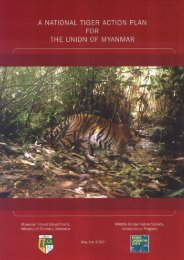Thailand Tiger Action Plan - Global Tiger Initiative
Thailand Tiger Action Plan - Global Tiger Initiative
Thailand Tiger Action Plan - Global Tiger Initiative
Create successful ePaper yourself
Turn your PDF publications into a flip-book with our unique Google optimized e-Paper software.
<strong>Thailand</strong> is one of the fast growing economies in Southeast Asia. Thetrade-off, however, is that the current forest cover is 28% of the countryarea, which is among the lowest in the region. Fortunately, <strong>Thailand</strong> beganestablishing wildlife and national park laws and a protected area systemalmost 50 years ago. The current protected area system covers about18% of the country area, and the Thai government has already invested inestablishment and running of 123 national parks and 58 wildlifesanctuaries. Besides protection of landscapes and their depending wildlifespecies, the government also undertakes various interventions includingnature education, alternative livelihood, and wildlife crime suppression.Despite the significant efforts and investments, the recent rigorousmonitoring systems have revealed that wild tigers are surviving inrecoverable numbers only in protected landscapes with a strong history ofprotection, especially in areas with active park guards and good patrolsystems. The on-going intensive population monitoring program hasrevealed that only one landscape, the Tenasserim-Western ForestComplex (Tenasserim-WEFCOM) can be counted as a “tiger source site”.More than 100 adult tigers have been photographed in this landscape overthe last 5 years. Tenasserim-WEFCOM about 25,000 km 2 on <strong>Thailand</strong>’sside, with habitat in Myanmar is a globally important tiger landscape. Thecore area is also a world heritage site.Another landscape that can qualify as a “potential source site” based oncamera-trapping evidence is Dong Phayayen–Khao Yai Forest Complex(DP-KY); also a world heritage site. About 8 adult tigers have beenphotographed from this 6,100 km 2 landscape. These two represent thelandscapes with the greatest potential for tiger recovery in <strong>Thailand</strong>.The success of the 12-year plan of wild tiger recovery is very muchdependent on: strengthening landscape-scale conservation interventionsin these two landscapes; rigorous research and monitoring; transboundaryconservation ties being strengthened to effectively control cross-bordertrade; and law and policy reforms to support the efforts to reach the visionand goals as stated in the action plan.Chote TrachuPermanent SecretaryMinistry of Natural Resources and Environment<strong>Thailand</strong>
















